USVs
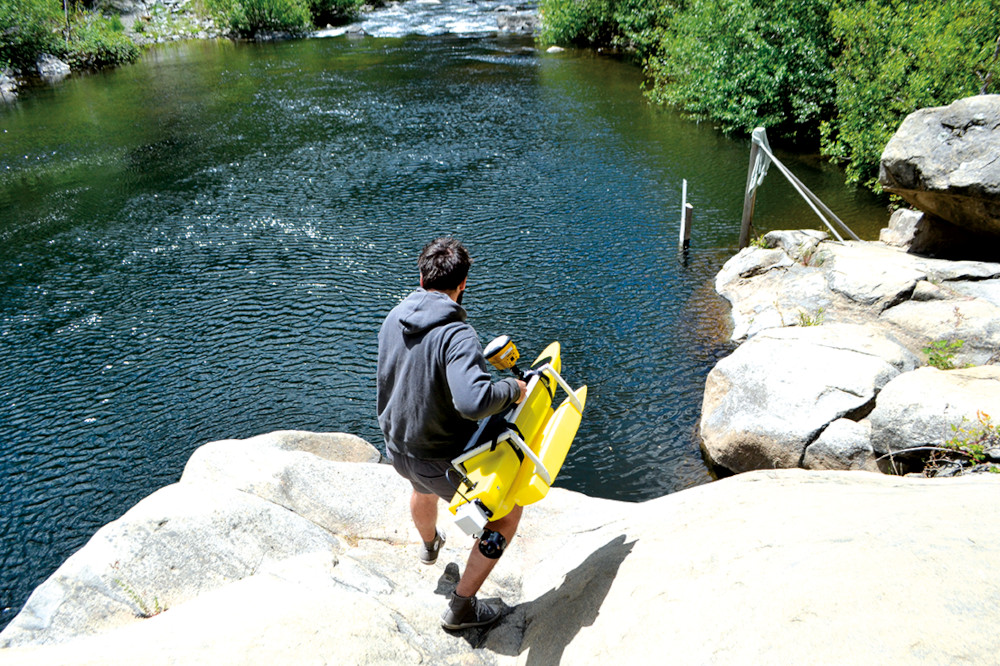
Survival of the fittest
Rory Jackson reports on how USV designs are evolving to withstand harsh conditions in a range of marine environments
Tailoring an autonomous vehicle to match the geography and altitude of its mission environment is most often the primary determinant of its success in operational and sales terms.
For instance, long-endurance UAVs for stratospheric flight are largely designed with ultra-lightweight wings of thin-film carbon tape and solar ‘foil’ to maintain lift in air of low density, while MALE UASs often feature thicker carbon (or even aluminium) wings to handle turbulence and vibrations from their engines. And down on the ground, many UGVs now come with legs for handling stairs in industrial settings, whereas off-road UGVs can feature thick, rugged tyres, tank treads or even screw drives for crossing otherwise impassable terrain.
One also starts to see similar patterns among USVs. Most USV platforms are being used for similar purposes – gathering sonar imagery, water quality measurements, IR scans or other critical data. But despite the similarities in mission and operating envelopes, USVs are not converging around a single design profile, instead they are being engineered to survive and function in the waters where they will be working. The latest generation of USVs reflects this trend perfectly.
Rivers and streams
When we last covered Seafloor Systems in detail (UST 33, August/September 2020), it was to investigate how it had customised one of its HydroCat-150 USVs to fit the tight physical clearances needed to survey the California Aqueduct.
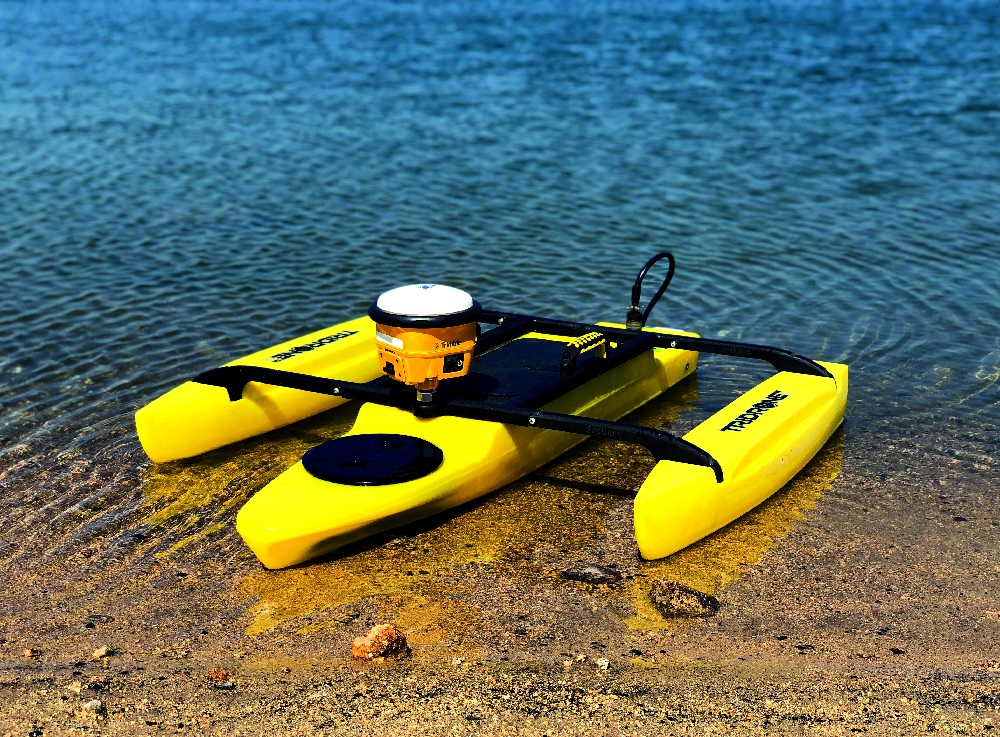
(Courtesy of Seafloor Systems)
Since then, the company has built USVs that are smaller and more convenient, with its latest project initially aimed at developing a backpack transportable craft. The idea behind it was that land surveyors and engineers would be able to carry such a vehicle with relative ease to hard-to-reach lakes, rivers, streams and small water bodies.
“Once we started testing the system, however, we actually found it to be extremely manoeuvrable and fast due to its small surface contact with the water and its integrated echo sounder transducer in the hull,” says CEO John Tamplin. “In fact, unlike our current HyDrone catamaran USV, there was no pole or transducer dragging in the water, enabling the system to work well in highflow situations on rivers and streams.”
With these advantages, Seafloor has continued developing the new platform, unveiling it as the TriDrone USV in March this year and offering it as a solution for inspecting water resources, riverine mapping, topographic surveys, reconnaissance applications and indeed any marine application where conventional transportation and launching are impossible.
The TriDrone is 121.92 cm long and measures 86.36 cm wide when deployed; this width decreases to 32.5 cm when folded for transportation. It weighs 10kg and can carry up to 11kg of payload mass, on a hull built largely from UVresistant HDPE and assembled about a frame of 15% fibreglass-filled Nylon.
The easy foldability was a primary development target. Tamplin says, “We wanted a unit that could be folded for quick and easy transport, and put to work without the need to re-assemble the unit every time it’s used. Simply unfold the outriggers, attach the servo-controlled thruster via the quick release, and you’re ready to go.
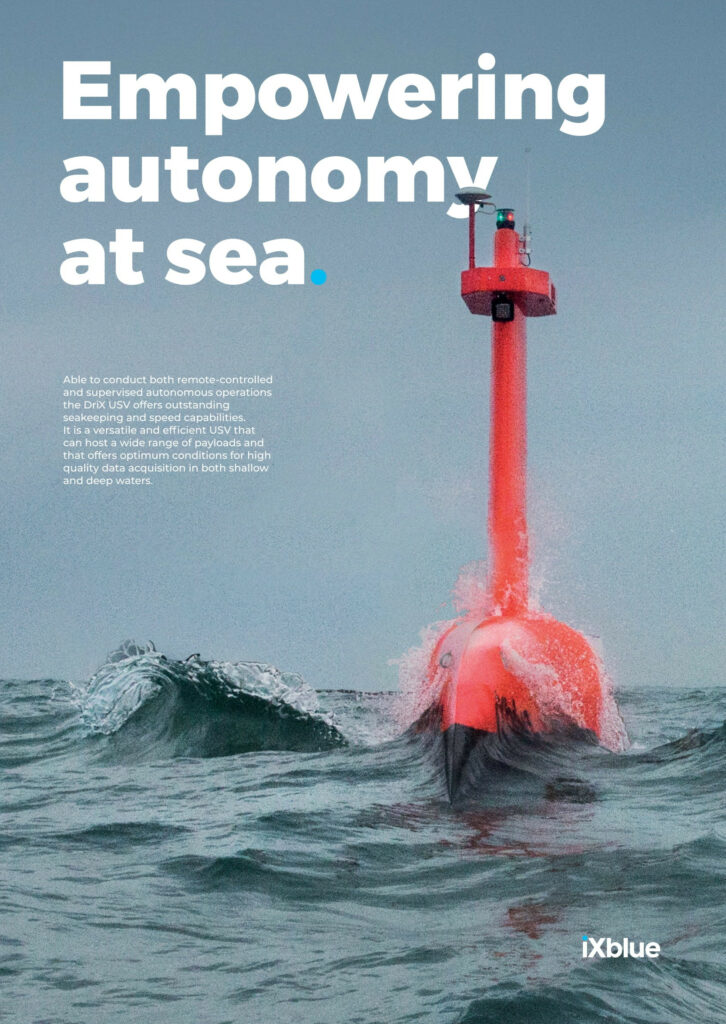
“This required quite a bit of design, testing and prototyping to get the final product we have now, while also making sure it was tough enough to handle transport and use in harsh environments.” The USV’s electronics are largely enclosed in stainless steel to ensure sufficient ruggedness for transport.
Once deployed at its mission location, the TriDrone’s trimaran design enables high manoeuvrability and stable traversing over fast-flowing streams and rivers, primarily through its minimised water-hull contact.
“And since the transducer is integrated into the hull it adds little if anything to the overall drag through the water,” Tamplin adds. “Plus the removeable, servo-controlled single thruster design enables the unit to turn and manoeuvre quickly and sharply in confined areas or to avoid objects.”
The TriDrone surveys at a speed of 3 knots to enable clear echo sounder data, although depending on its payload it can move at up to 6 knots. Its motor is a BLDC system fitted with a weed guard to prevent blockages, with energy coming from a 16 Ah lithium-polymer battery pack over a 14.8 V bus. Two 120 A ECUs provide redundant electronic control, and navigation is supplied by the end-user’s choice of GNSS (the vehicle is compatible with all brands).
“While the TriDrone is currently in a single-beam echo sounder configuration, we are testing the integration of an acoustic Doppler current profiler into the system for conducting river flow calculations during high water events,” Tamplin notes.
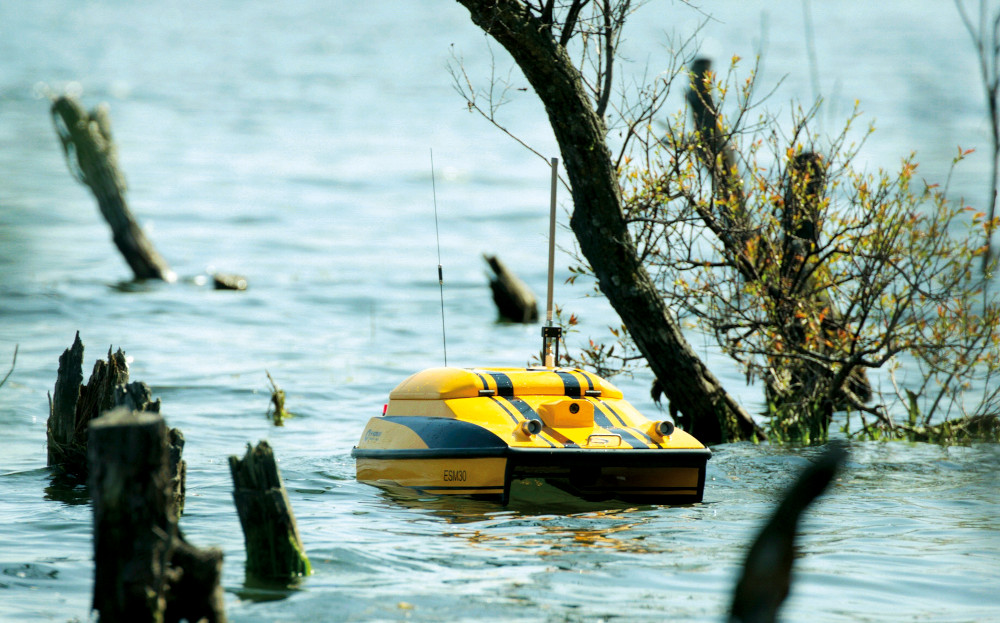
(Courtesy of OceanAlpha)
With specific niche operations being demanded by maritime businesses, Hong Kong-based OceanAlpha has also developed a number of specialised USVs for different environmental monitoring tasks.
The ESM30 for instance is its first craft designed especially for sampling water quality. It measures 115 x 80 x 43 cm and moves at up to 2 m/s (4 knots), with up to 3 hours of endurance if a survey speed of 1 m/s is maintained.
For additional safety when surveying autonomously in ports, harbours and other potentially congested locations it has a built-in obstacle avoidance capability powered by ultrasonic sensors about its fibreglass and carbon-Kevlar hull, which is designed with a catamaran shape for high stability.
It is compatible with numerous sensor probes from different brands, enabling it to monitor parameters such as pH, dissolved oxygen, turbidity, conductivity, temperature, oxidation reduction potential, chlorophyll and blue-green algae growth. Samples are collected in four onboard bottles of around 1.8 litres each from 0.5 m below the waterline before being measured; sampling can also be performed autonomously at present waypoints as pre-programmed in the mission planning software.
“Water quality graphical reports can then be automatically generated from real-time survey data transmitted from the USV’s antennas to the GCS, either for routine monitoring or for emergency responses to pollution incidents in water supplies, aquaculture, municipal administration and environmentally protected areas,” according to Ran Zhang, OceanAlpha’s general manager.
More recently, OceanAlpha has also introduced its ME120 flow injection monitoring USV, which integrates a multiparameter online water quality analyser and a flow injection analysis system for measuring ammonia, nitrogen and total phosphorus levels. Its vessels have been used to investigate and prevent illegal river sewage discharges in Taizhou, Jiangsu province, as well as with multi-beam and sidescan sonar mapping systems.
Lakes and harbours
CEiiA was founded to support efforts across Portugal’s automotive industry. These days however, it has diversified its portfolio to include maritime autonomy, unveiling its Orca USV at Oceanology International 2022 in London.
The Orca is a hybrid-electric platform built on a catamaran hull measuring 3.4 m long, 2.7 m tall and 1.7 m wide. Its total weight is 450 kg, with a 100 kg payload capacity. Helder Oliveira, head of electronics and embedded systems at CEiiA, says,
“Orca’s development started in 2017, with the first concept of the vehicle being focused on bathymetry surveying missions. Following a USV market evaluation, we decided to expand the mission requirements, rendering the Orca to become a multi-purpose platform.”
With the physical structure largely defined by 2018, CEiiA then started onboard software development to enable the Orca to navigate autonomously. A year later, the first sea trials were performed to validate its behaviour, control and navigation.
The system can operate for up to 24 hours from launch to recovery, with a top speed of 5 knots thanks to its two electric thrusters outputting a collective 12 bhp at peak power. Data gathered from its payloads (as well as vehicle control and health information) during this time can be communicated over LTE links, wi-fi or cellular SMS updates for individual alerts.
“To achieve a payload capability of 100 kg on a vessel less than 4 m in length, and to operate such a sensor complement autonomously, demanded very precise structural development in parallel with extensive attitude analysis and control development,” Oliveira adds.
“Also, an autonomous winch for deployable payloads and the ability to achieve a maximum endurance of 24 hours mean the vehicle can perform different types of missions without significant time constraints.”
In addition to hydrographic survey missions such as bathymetry on lakes, rivers, reservoirs and transitional waters, CEiiA envisions the Orca performing surveillance or inspection in even shallower waters as well, as it says it is safer to use than manned platforms or those with deeper drafts.
It also anticipates scientific research missions such as environmental monitoring, water quality measurements and geological or geophysical exploration as key applications, along with defence operations such as MCM or reconnaissance. The Orca can also be reconfigured to function as a launch & recovery platform for UAVs or as a comms relay system, potentially aiding in search & rescue, offshore inspection and other applications.
“With this multi-mission capability in mind, one of the major challenges was to ensure that proper navigation stability is achieved during all types of operations,” Oliveira notes. “Consequently, the Orca’s navigation and control systems were deemed critical and hence given the greatest attention during the development phase of the project.
“Building on the experience gathered to develop the Orca, we are securing investment to develop a larger platform for coastal and open waters. The goal is to have a set of USVs fit for operations in a complete range of marine spaces. In the shorter term we’ll investigate possible upgrades to the vehicle command & control capacities as well as to the OS and UI.”
Extreme sea states
The longer and further a voyage on the open sea, the more challenging the mission becomes, particularly with regard to the survival of the vessel. This challenge is perhaps best illustrated by the fact that every attempt to cross the Atlantic autonomously has failed, although at time of writing, the Mayflower Autonomous Ship (investigated in detail in UST 42, February/March 2022) was halfway through its second attempt and had reached the Azores.
Julie Angus, CEO of Open Ocean Robotics, understands the hazards of the Atlantic environment, having spent considerable time in small boats on the ocean, including 5 months rowing from Portugal to Costa Rica.
“That experience made me recognise just how challenging it is to be on the open ocean and how those difficulties limit our ability to protect and operate on the sea,” Angus says.
“We decided to develop a self-righting solar-powered USV, because we wanted to create something that could be deployed for potentially months at a time, and endure the extreme sea states it would encounter if it voyaged to remote regions, as we did in our rowboat.
The Canadian company now has multiple USVs in operation that offer services in marine mammal monitoring and maritime domain awareness, and continues to build its fleet in order to offer more services through its continuous passive acoustic, optical and other data-gathering capabilities. It has also provided its craft for hydrographic surveying, marine ocean current profiling and illegal fishing prevention missions.
Its flagship Data Xplorer USV is a modularly designed single-hull craft that can house various mission sensors. Its architecture features both wet and dry sensor bays as well as an elevated sensor mount, with additional modularity in the battery storage compartment to enable increased duration at which more powerful sensors can be run, as well as a low-power mode where the vessel can be recharged by sunlight.
“The Data Xplorer is very capable in high sea states, which makes it suitable for the open ocean and more challenging seas,” Angus adds. “It’s also highly controllable and has a shallow draft, allowing it to be used in nearshore as well as offshore environments.
“And because its operations produce very little noise that might otherwise interfere with acoustic signals, any integrated sonars will generate highly accurate imagery. That’s also important for running the USV among marine lifeforms without impacting them, and being entirely solar-powered and producing no greenhouse gas emissions or risk of oil spills further helps keep it sustainable for ocean monitoring.”
Open Ocean Robotics’ passive selfrighting system is a buoyancy-based design, which avoids relying on ballast as that would add weight, and also avoids using anything that depends on moving parts or excessive draft or weight.
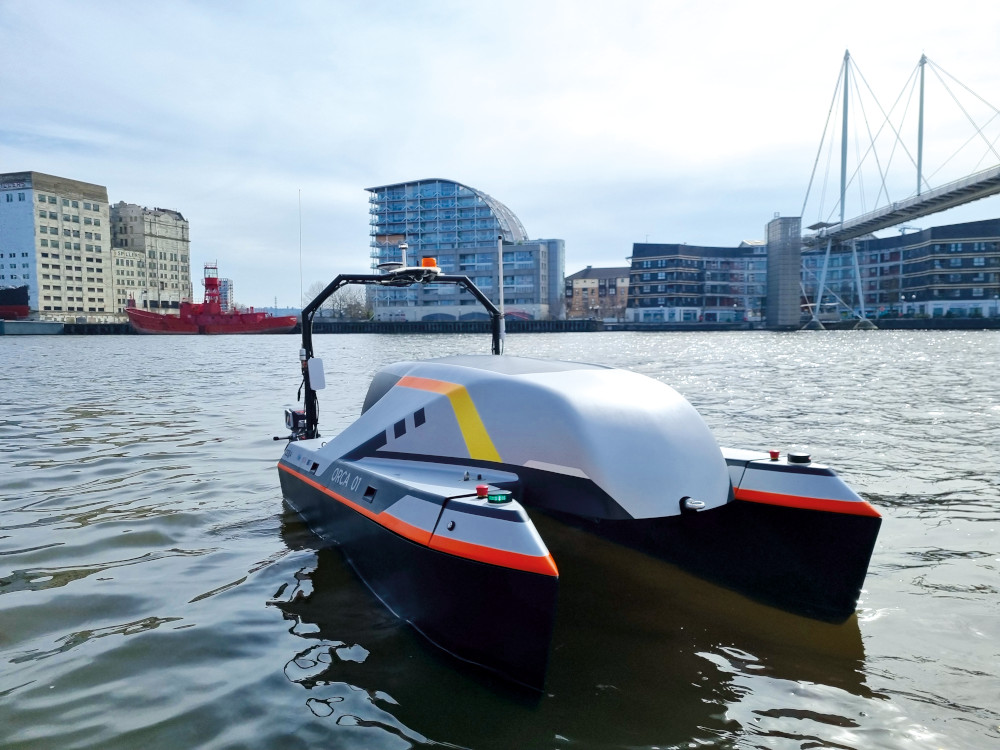
(Courtesy of CEiiA)
“Instead, a roll bar structure sits on the aft of the USV to create an inherently unstable position when in an inverted or partially inverted orientation,” Angus explains. “We went through several iterations to fine-tune the structure as well as the hull shape to maximise its self-righting capabilities while minimising its impact on performance, ultimately deciding on the foil-shaped structure on our current version.
“In our upcoming USVs, you’ll see some slight modifications to the system to accommodate heavier payloads.”
This design philosophy lends the Data Xplorer towards maintaining straight tracks and system performance in adverse conditions: the company has tested it in surf breaks where it has repeatedly capsized and self-righted. It has then maintained its course with full control throughout those conditions, and in other trials withstood winds of 45 knots, still able to make its way into headwinds and handle the high waves.
“These capabilities are enabled by the streamlined shape of the hull, as well as a full keel and rudder shape, which allow it to resist sideslip and glide through the water with minimal resistance,” Angus adds.
“We also have some r&d initiatives that include building a new, larger USV, advancing our onboard data processing for increased autonomy, and enhancing the functionality of our portal Xplorer View to provide more functionality in data analytics as well as command & control.”
Over the horizon
We previously reported on the REAV-40 USV from HydroSurv, and how it was being used as a research platform for gathering data on offshore wind farms, in UST 37 (April/May 2021). Building on that, the UK-based company’s upcoming REAV-60 has evolved out of several collaborative r&d, trials and testing initiatives with Sonardyne and other partners, running in tandem and focusing on different areas of technological development.
“While HydroSurv can now offer USVs in different sizes and with different capabilities, the REAV-60 was conceived as our longendurance platform – our first over-thehorizon or BVLOS-capable vessel,” says David Hull, founder and CEO of HydroSurv.
“To that end, it was developed for up to 14 days’ endurance, which has been enabled through a new hybridisation system consisting of Fischer-Panda and Mastervolt equipment we’ve been testing for the past 6 months.”
Rather than merely plugging together turnkey systems, HydroSurv’s engineers have collaborated with Dynautics to develop optimisation algorithms for the REAV-60’s autopilot. That provides intelligent control of the Fischer-Panda AGT 6000 DC genset, which charges the Mastervolt lithium battery clusters at precise points of mission routes as influenced by operational or environmental constraints.
“Through the optimisation system, we can enforce ‘no-charge zones’ to reduce noise at certain points during the mission, or initiate charging to arrive fully charged at a particular waypoint – for instance if there’s a series of sequential inspections or data harvesting positions, or if the vessel is operating in an area where it is desirable to reduce greenhouse gas emissions,” Hull adds.
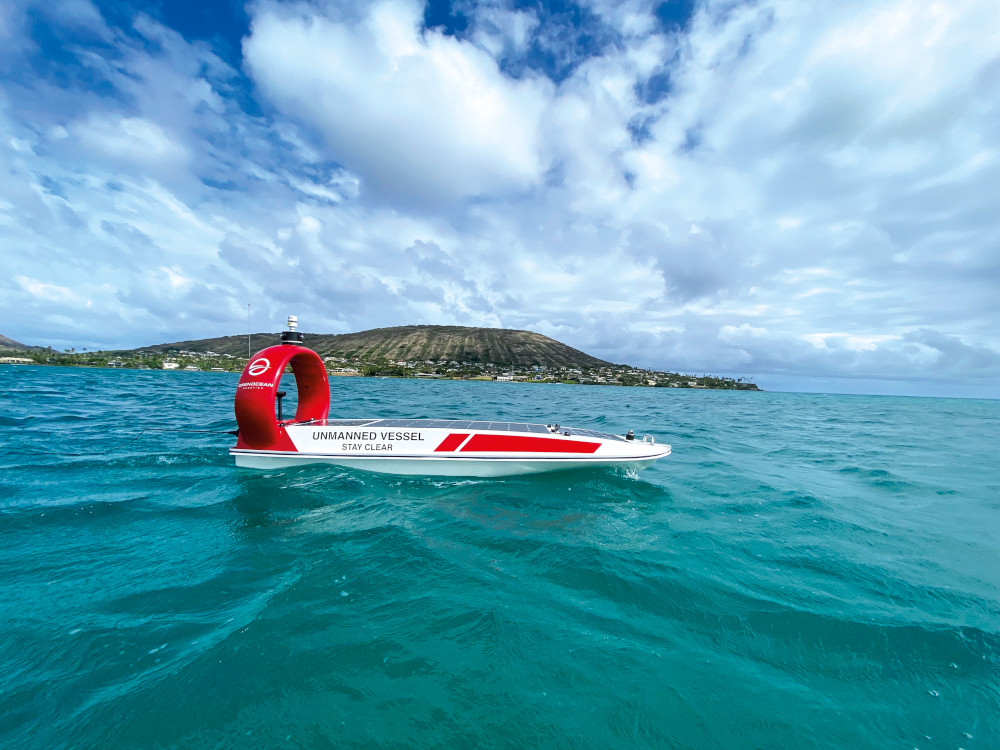
(Courtesy of Open Ocean Robotics)
“Beyond that, there are further measures in place to optimise the batteries’ charge cycle, building on everything we’ve learned about battery cycle life optimisation gained from our previous experience of constructing and operating our all-electric USVs.”
Propulsion meanwhile comes from two Fischer-Panda 3.8 kW electric pod drives, re-engineered to operate as outboards for easier maintenance and equipped with propellers optimised for hydrodynamic efficiency at 7.2 knots. With this powertrain, HydroSurv anticipates offering the REAV-60 as a multi-mission platform for gathering data over time across hydrographic survey, environmental monitoring, inspection of offshore assets and similar applications.
To maintain reliable real-time monitoring and data streams during BVLOS missions, a number of comms technologies are used, including a Thales VesseLink 700 Iridium satellite system, a PepLink cellular router system, and a Ubiquiti wi-fi system for short-range, highbandwidth comms when available.
“We’ve elected to use off-the-shelf equipment with good operating precedents in remote applications,” Hull notes. “The USV’s host network has been integrated and configured for graceful failover from one data link to another.
“A large part of the development work for the REAV-60 focused on developing our proprietary command & control system with a long-endurance capability as a core focus of the design. Electrical power distribution and control hardware running in the USV is dual redundant, with an embedded PLC providing control and monitoring functionalities alongside a separate watchdog system to enhance the system level of integrity.
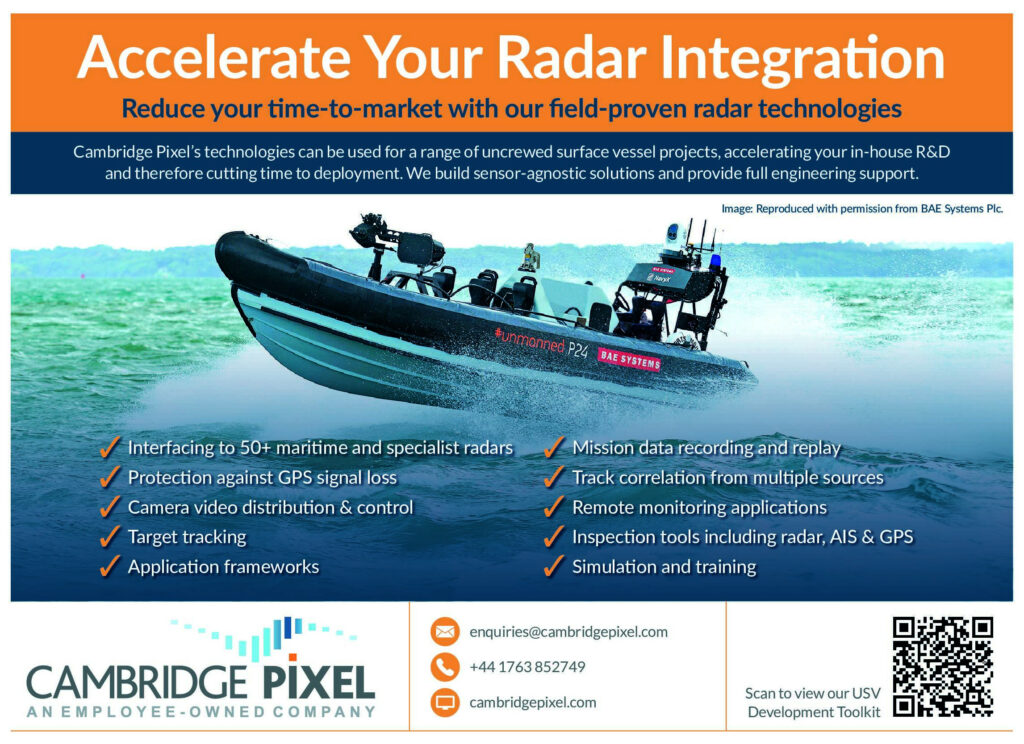
“For BVLOS USV missions to become a commercial norm, integrity and trust are critical factors that must be satisfied to achieve adoption and regulatory approval. At HydroSurv, our aim is to keep our engineering decisions one step ahead of incoming regulation and technical standards.”
Such are the reliability, long endurance and high-energy capabilities of the REAV- 60 that it is also being used as the USV platform for the Arowind (Autonomous Remote Offshore Wind Inspection, Navigation and Deployment) Project.
This is a $6.7 million study led by Voyis Imaging in collaboration between HydroSurv and Deep Trekker (with other companies also supplying components), that is co-funded and overseen by Canada’s Ocean Supercluster to show how USVs, ROVs and special data-gathering payloads can be used to inspect ocean wind farms safely and cost-effectively.
With autonomous vehicles being deployed from both remote and resident launch points (relative to the wind farms’ locations) as part of the project, Arowind is expected to create 55 new direct jobs and an estimated 275 indirect jobs around the operations of the marine uncrewed systems.
Summary
There are numerous hydrography and water quality inspection platforms that look distinctly different from one another. The differences in configuration and componentry point to the industry’s maturity and the quality of naval architects being employed during their design. They also raise the question of where the industry will go next.
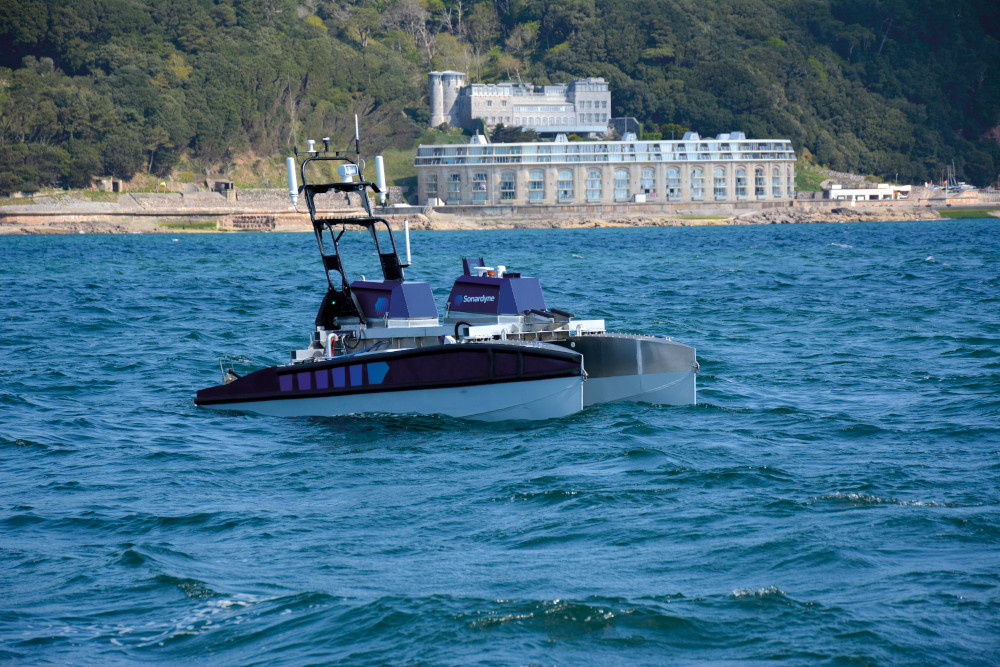
(Courtesy of HydroSurv)
Looking beyond oceanology, to the burgeoning worlds of uncrewed logistics and autonomous passenger transport by sea, there are plans for USVs shaped much like conventional cargo ships and crewed water taxis. But the wider autonomous world also has unconventional and intriguing design choices.
Some were once considered lost to history, such as the tail-sitter aircraft. Once dismissed as a conceptual blunder, the UAV market is now rich with demand for tail-sitters such as the V-Bat and Valaq (see UST 14, June/July 2017, and UST 32, June/July 2020, respectively). Others take biological inspiration, such as the fourlegged ANYmal UGV (UST 40, October/November 2021) and many others.
Certainly, something akin to ocean logistics USVs being built like Viking longships, or reconnaissance USVs shaped like alligators, might seem farfetched. But given the market’s need for high efficiency and survivability on rivers, lakes and oceans, USV engineers may well be the next group of designers to draw on the many inspirations available to them from across history, zoology and beyond.
UPCOMING EVENTS
























